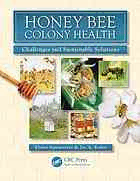
Honey bee colony health : challenges and sustainable solutions PDF
315 Pages·2012·21.115 MB·English
Most books are stored in the elastic cloud where traffic is expensive. For this reason, we have a limit on daily download.
Preview Honey bee colony health : challenges and sustainable solutions
Description:
Content: Honey bee health: the potential role of microbes -- Seasonal microflora, especially winter and spring -- Evaluation of Varroa mite tolerance in honey bees -- Status of breeding practices and genetic diversity in domestic U.S. honey bees -- Global status of honey bee mites -- Challenges for developing biopesticides against Varroa -- Molecular forensics for honey bee colonies -- Honey bee viruses and their effect on bee and colony health -- PCR for the analysis of Nosema in honey bees -- Nosema ceranae detection by microscopy and antibody tests -- Chalkbrood re-examined -- Critical transition temperature (CTT) of chalkbrood fungi and its significance for disease incidence -- Small hive beetle (Aethina tumida) contributions to colony losses -- Pesticides and honey bee toxicity in the United States -- Cellular response in honey bees to non-pathogenic effects of pesticides -- Differences among fungicides targeting the beneficial fungi associated with honey bee colonies -- Fungicides reduce symbiotic fungi in bee bread and the beneficial fungi in colonies -- Interactions between risk factors in honey bees -- Understanding the impact of honey bee disorders on crop pollination -- Calculating and reporting managed honey bee colony losses -- Conservation of plant-pollinator mutualisms.
See more
The list of books you might like
Most books are stored in the elastic cloud where traffic is expensive. For this reason, we have a limit on daily download.
